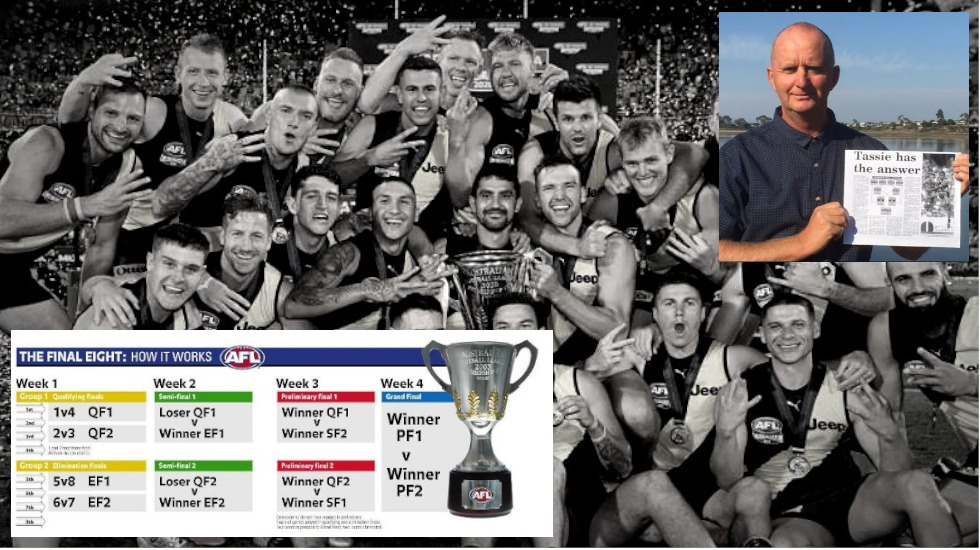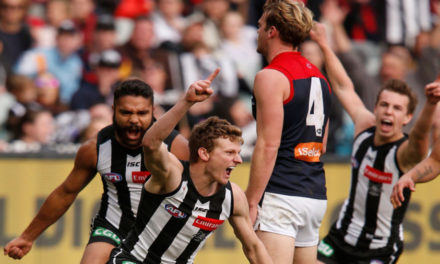Tasmanian phys-ed teacher Kim Crawford wants the AFL to acknowledge that he created modern top-eight system.
“THIS has been a Crawford Production”.
Hector Crawford was proud to put his name to his shows during the black-and-white pioneer days of Australian television from the late 1950s and the halcyon conversion to colour during the 1970s – Homicide, Division 4, Matlock Police, Bluey, The Sullivans …
And the copyright on those programs must have served handy with royalties on every re-run.
Kim Crawford might just need Lucky Grills in the role of Det Sgt “Bluey” Hills to barge AFL House to settle if the current top-eight system used for the national league’s annual finals should also be tagged a “Crawford Production”.
This Crawford is a physical education school teacher at Carlton River, south-east of Hobart. For two decades he has been fervently asking (with no courteous response) the AFL hierarchy why – in contrast to the 20th century – the finals system carries no label.
In the beginning, with the VFL introducing finals at the end of its inaugural season in 1897, there has been the Argus systems (in recognition of the Melbourne newspaper that promoted the concepts) and the Page-McIntyre and McIntryre models. The latter recognises the work from 1931 of lawyer, historian and English lecturer Ken McIntyre to develop finals formats for four, five, six and eight teams – just as cricket acknowledges English statisticians Frank Duckworth and Tony Lewis with the Duckworth-Lewis method.
Since 2014, cricket’s algorithm for limited-over matches has recognised Australian data scientist Professor Steven Stern for amendments to the formula used to settle games shortened by weather or bad light.
Generally, having one’s name listed on a rule in sport is asking just to be remembered for the inevitable blame games – and there were a few of those during the 1990s when the AFL had more than growing pains during September while expanding the major round from six to eight teams.
And it was much more than just that contract to play finals, particularly preliminary finals, at the MCG that corrupted the integrity of the major round.
For those who need a jolt to the memory bank, the McIntyre final-eight system worked to the theme of pairing teams from opposing ends of the top-eight ladder in the first week of finals – 1 v 8; 2 v 7; 3 v 6; and 4 v 5. Much like tennis seedings at a major tournament such as Wimbledon.
But it was not strawberry and cream for Geelong fans who need no reminder of how this played out to their club’s disadvantage in 1997.
First up, their second-placed Cats were locked in the only qualifying final that gave a home-ground advantage to the lower-ranked team – seventh-placed North Melbourne at the MCG.
On losing this “qualifying final” by three goals, Geelong was then forced to travel to Football Park in Adelaide to play Malcolm Blight’s fourth-ranked Adelaide in a semi-final … the one also remembered for field umpire Grant Vernon not rewarding future Geelong captain Leigh Colbert for one of the most courageous marks in the sport’s history.
The 1998 finals series created more dismay, particularly after the qualifying final between fourth-ranked Melbourne and defending champion, fifth-placed Adelaide, effectively became a dead rubber with no consequence to Blight’s team (except to key forward Tony Modra) for losing by 48 points at the MCG.
A year of significant public debate during 1999 had the AFL finally concede the system needed to change – so that every final had a clearly defined consequence and finished with each team certain on where it stood in the finals race.
Hence the format of double-chance qualifying finals, 1 v 4 and 2 v 3 with the winners hosting preliminary finals and losers hosting semi-finals; and knock-out elimination finals, 5 v 8 and 6 v 7. Also, a top-four side could not be eliminated in the first week.
In Tasmania, Kim Crawford had foreseen the debate five years earlier – in 1994 – when the finals series expanded from six to eight teams. He quickly offered the solution that seemed so obvious to others by 1999.
“I was reading the local paper after the AFL put up the (new McIntyre final eight for season 1994) and thought it was messy and not easy to understand,” Crawford told Footyology.
This is an understatement considering as many as two finals in the first week ran the risk of being “dead rubbers” if the eighth- and seventh-ranked teams lost their play-offs to the top-two seeds.
“I could see the problem,” Crawford adds. “I thought there must be a better way. And I came up with a better system – and sent it to the AFL.
“It amazed me that the AFL could not see fault with the McIntyre final eight. That is why I wrote to all the AFL clubs, lobbying them for three to four years to push my case for a new system. Each year, the faults in the McIntyre system became more evident and the support from the clubs for my system grew. Their letters show their willingness to adopt and promote my case.
“There always will be some people who will find some reason not to like it. But it has proven across the past 21 years to have none of the controversy we saw with the McIntyre final-eight and final-six systems.”
For the past 25 years Crawford has sought – with no satisfaction – the AFL to acknowledge he is the author of the finals system, as the league has done with the Argus newspaper and Ken McIntyre on previous finals models.
Footyology blew the dust off this file – and added more baffling notes – while consulting Crawford on the new final-six system being adopted for next month’s AFLW major round.
PLEASE HELP US CONTINUE TO THRIVE BY BECOMING AN OFFICIAL FOOTYOLOGY PATRON. JUST CLICK THIS LINK.
It is no replica of the AFL final six used from 1991 to 1993 with two McIntyre systems.
In 1991, the finals began with two elimination finals (3 v 4 and 5 v 6) and a qualifying final between the top-two teams. The grand final delivered minor premier West Coast facing second-placed Hawthorn at Waverley Park.
In 1992, McIntyre tweaked the elimination finals to have 3 v 6 and 4 v 5 – to correct the flaw that previously had the fourth-ranked team starting against a tougher opponent than the fifth-placed team would face.
Still, even with this correction, the final-six model created another problem during the semi-finals with the allocation of a double-chance to the elimination final winner but not the qualifying final loser.
AFLW chief Nicole Livingstone has taken in the history lesson. Or has she?
The AFLW top-six final series works to this model:
WEEK ONE (April 4): Elimination finals, 3 v 6 and 4 v 5. Top-two teams rest.
WEEK TWO (April 10): Preliminary finals, 1 v winner of 3 v 6; 2 v winner of 4 v 5.
WEEK THREE (April 18 or 19): Grand final with the preliminary final winners.
Footyology asked Crawford – while the AFL does not – to review this system. His response takes him back to the start of this saga he was reading in his local newspaper noting a problematic McIntyre final-six system for the AFL.
“I don’t mind that the teams that finish first and second get the first week of the finals off considering that all games played are ‘sudden death’,” said Crawford.
“My only criticism would be that if games went according to the seedings, the preliminary finals would end up being 1 v 3 and 2 v 4. Obviously, this is a mismatch of seedings and should be reversed so 1 v 4 and 2 v 3 which is easily done.”
If only resolving Crawford’s request – that the current AFL final-eight system be attributed to its author, be it him or not – was as easy to resolve.
Crawford has a compelling file to present to any jury on how he took issue with the first McIntyre final-eight system in 1994 – and the AFL has repeatedly told Crawford that he will need a magistrate or jury in a courtroom to settle the saga. The AFL also has repeatedly declared many experts and analysts – both inside and outside AFL House when it was at the MCG – had workshopped the finals system before Crawford had penned his papers that drew support from each AFL club he canvassed during the mid-1990s.
“When I first sent my final-eight system to the AFL in 1994,” Crawford told Footyology, “I did so trying to help them, thinking they would see its benefits straight away and possibly adopt it the following year.
“I was hopeful they would appreciate my contribution and that might possibly be rewarded with a couple of grand final tickets. I got that horribly wrong!
“I certainly didn’t expect it would take another six years of considerable time and effort to convince them to use my system, especially as so many of the clubs offered me their support very early on.
“I also didn’t expect their deceitful conduct in claiming my system as their own. Twenty-one years later and they still refuse to be truthful about this aspect of their finals history.”
Crawford’s account of these 21 years is worthy of another Hector Crawford crime series. The script, so far as Crawford recalls the tale, involves the AFL, the league’s integrity unit, a former AFL coach, the league’s official statistician, a federal politician and a few media platforms, in particular the national broadcaster, the Australian Broadcasting Commission.
“It is unbelievable,” says Crawford of the saga and the AFL that has maintained one well-worn response.
“They say the system is their own,” adds Crawford. “They tell me, ‘Someone before you came up with this system’. I only ask they show me the evidence. They (the AFL) say they won’t unless I take it to court.
“I am still trying to get them (the AFL) to tell the truth. The system has been in use for 21 years now. It works alright. They just need to tell the truth.”
Back to the now, the current AFL final-eight format is challenged by the pre-finals bye. Crawford’s read on this change is: “I don’t like it. It is not a good idea (for the way the race to the AFL premiership plays out across the month-long major round). If the top-two teams win in the first week, they are not playing much football – not enough football – during that month. They can struggle to maintain the momentum they took into the finals.”
Crawford’s fight for recognition – or the AFL final-eight format to again carry a name to honour its author – gained new momentum in 2016 when former St Kilda coach Grant Thomas took up the issue to social media on his well-followed Twitter account. The ABC followed up by reporting the Tasmanian teacher’s plight. In 2017, Labor federal politician Brian Mitchell made mention of the saga in Canberra and wrote two letters to the AFL chief executive Gillon McLachlan with Crawford saying, “It blows me away that they won’t even answer a federal politician.”
Most fascinating is the chapter that begins with Crawford sending an email to the AFL integrity unit. “I had a woman in the integrity department contact me saying she would look into it,” said Crawford. “Then nothing … no finding, no denial.”
So far, the most-detailed conversation – if it can be called such – from AFL House to Crawford has been through league statistician and historian Col Hutchison. “He told me a couple of people sent this final-eight system to the AFL before me,” said Crawford. “Okay, say who was first … I will keep pushing until we get the truth.”
Footyology contacted the AFL for its response to Crawford’s long-standing claims to being the author of the current final-eight model. The league’s response was in keeping with its “non-response” of preferring to not comment.













The AFL resurrected the system used by the ARL in 1995-96.